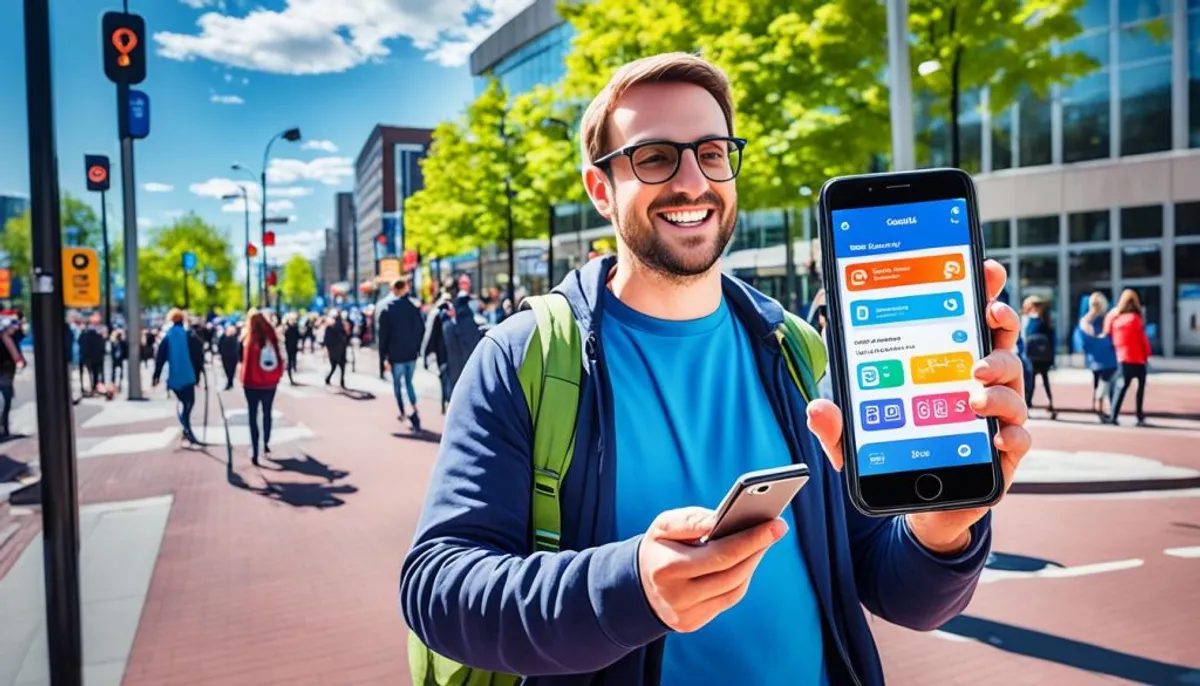In today’s digital age, social media is a big part of our lives. The latest data shows that many U.S. adults use platforms like YouTube, Facebook, and Instagram. YouTube leads with 83% of American adults using it. Facebook is close behind with 68%, and 47% use Instagram.
Other platforms like Pinterest, TikTok, LinkedIn, and Snapchat are used by fewer adults. Yet, social media is getting more accessible and a part of daily life for Americans. Mobile apps and easy interfaces have made these social media platforms easy for everyone to use.

Social media keeps growing and reaching more people in the U.S. It’s clear that these platforms are getting easy to access and user-friendly for more people. This shows that social media is becoming more inclusive and changing how we connect and share online.
The Impact of Social Media on Mental Health
Social media has changed how we talk, share, and connect. It offers chances for social interaction and building communities. But, it also has negative effects, especially for young people, including negative mental health impacts.
Negative Effects of Social Media Usage on Young People
Experts at Columbia University worry about the mental health risks of too much social media use. This is true for teens and young adults. The main issues include:
- Cyberbullying and Online Harassment: Social media can be a place for cyberbullying. This can really hurt the mental health of young people.
- Unrealistic Expectations and Body Image: The perfect images on social media can make people feel bad about themselves. It can harm their self-image and body confidence.
- Normalization of Risky Behaviors: Seeing certain content on social media can make unhealthy behaviors seem normal. This includes things like substance abuse or eating disorders.
Studies show that using social media a lot is linked to more depression and anxiety in young people, especially girls. It can also lead to eating disorders. Seeing perfect bodies all the time can deeply affect their mental health.
| Mental Health Concern | Link to Social Media |
|---|---|
| Depression | Using social media more is linked to more depression |
| Anxiety | Using social media more is linked to more anxiety |
| Eating Disorders | Eating disorders are linked to seeing perfect bodies on social media |
Social media has its good sides, like helping people connect and build communities. But, experts say it’s key to set healthy limits on its use. This is especially true for teens and young adults. Their mental health can be greatly affected by their social media use.
The Widespread Use of Social Media Platforms
In the United States, social media has become a big part of life for millions. The Pew Research Center recently shared data showing how widely these digital tools are used, including various social media platforms statistics that highlight their usage trends.
YouTube and Facebook lead as the top social media sites, with 83% and 68% of U.S. adults using them often. Instagram, Pinterest, TikTok, and LinkedIn also have a lot of users.
Young people, especially those under 30, use many social media platforms. For example, 78% of 18-29-year-olds use Instagram, while only 15% of those 65 and older do. Also, 62% of young adults use TikTok, but only 10% of those 65 and older do.
These stats show how common social media platform usage is and the different groups of users in the U.S. As social media penetration and adoption trends change, the growth of social media user growth keeps evolving with digital life.
| Social Media Platform | Usage among U.S. Adults |
|---|---|
| YouTube | 83% |
| 68% | |
| 47% | |
| 32% | |
| TikTok | 33% |
| 28% |

Age Differences in Social Media Usage
Social media is a big part of life for the young, but older adults are catching up. A Pew Research Center survey shows big differences in how people of different ages use social media in the U.S. This highlights the importance of protecting teens online as they navigate these platforms.
Younger adults, especially those under 30, use many social media platforms more than older people. For example, 78% of 18-29-year-olds use Instagram, but only 15% of those 65 and older do. Young adults are also more likely to use Snapchat and TikTok, with 65% and 62% respectively, while only 4% and 10% of seniors do.
But, some social media sites are popular across all ages. YouTube and Facebook are used by most adults, showing that social media is a big part of life for many Americans, no matter their age.
These results show that social media usage by age and generational social media trends are changing the way we use the internet. Teen social media use and senior social media adoption are very different. Knowing these differences is key for businesses, policymakers, and people to use social media well, as well as ensuring access to information and research.
Is Social Media Easy to Access?
The data shows that social media platforms are now easy and friendly for most Americans. Smartphones and mobile-optimized apps have made these platforms a big part of daily life for many U.S. adults.
YouTube is the top online platform, used by 83% of American adults. Facebook, the second biggest social media site, is used by 68% of adults. Other platforms like Instagram (47%), Pinterest (32%), TikTok (33%), and LinkedIn (28%) show how common social media is in the U.S.
Easy-to-use interfaces, responsive mobile social media apps, and smooth cross-device use make social media easy for everyone. This ease has helped make these platforms a big part of American life.
The data clearly shows that social media is easy and friendly for most Americans. With smartphones and mobile-optimized social media apps, these platforms have become a big part of daily life for many U.S. adults.
Demographic Differences in Social Media Usage
Social media use varies a lot across different groups in the U.S. The Pew Research Center found big differences in how people of different races, ethnicities, and genders use social media, especially among adolescents and social media.
Race, Ethnicity, and Social Media Usage
Hispanic and Asian adults use Instagram more than Black and White adults. For example, 58% of Hispanic adults use Instagram, while 46% of Black adults do. Also, 49% of Hispanic adults use TikTok, which is more than other groups.
Gender Differences in Social Media Use
Women use social media like Instagram and TikTok more than men. For instance, 40% of women use TikTok, but only 25% of men do.
How much education someone has also affects their social media use. People with more education often use LinkedIn, a professional platform.
| Demographic Group | Instagram Usage | TikTok Usage |
|---|---|---|
| Hispanic | 58% | 49% |
| Asian | 57% | 29% |
| Black | 46% | 39% |
| White | 43% | 28% |
| Women | N/A | 40% |
| Men | N/A | 25% |
These trends show how different groups in the U.S. use social media in various ways. It’s important to understand these differences. This helps us know how to meet the needs of different groups in social media.
Strategies for Healthy Social Media Engagement
Experts and young people stress the need for healthy social media habits. Many teens and young adults who faced social media addiction suggest taking social media breaks or deleting accounts to boost mental health. They point out how social media can be addictive and shouldn’t control one’s self-esteem or reality.
Adding “friction” to social media use, like apps that limit time or require effort to continue, promotes mindful and balanced social media engagement. Parents should team up with their kids to create healthy social media habits. They should set time limits and talk openly about the good and bad sides of these platforms.
Being thoughtful and proactive helps both individuals and families enjoy social media safely. This means limiting social media time, taking social media breaks, and being mindful in how you use it. Additionally, it is crucial to consider the mental health impacts of social media use, as excessive engagement can lead to various emotional challenges.
| Healthy Strategies | Benefits |
|---|---|
| Limiting social media time | Reduces the risk of addiction and negative mental health impacts |
| Taking regular social media breaks | Allows for mental and emotional recharging |
| Mindful social media consumption | Encourages a more balanced and healthy relationship with social media |

By following these healthy social media habits, people and families can enjoy social media’s benefits. They can also reduce the risks and negative effects it might bring.
The Role of Parental Guidance
Teens today face a lot in the digital world. Parents are key in teaching them how to use social media wisely. Many teens want more help from their parents in this area.
Parents need to learn about the good and bad sides of social media. Talking openly with their teens about online activities is important. Protecting teens online involves setting limits on screen time and using apps that help with mindful use to prevent social media addiction.
Supporting Teens with Balanced Screen Use
Parents should show their teens how to use social media in a balanced way. This means having “no-screen” times, doing family activities offline, and talking about how social media affects mental health.
Working with their kids, parents can help teens use social media platforms positively. It can be a tool for connecting and expressing oneself, not causing stress or sadness. This approach helps teens have a good relationship with social media now and later.
| Parental Guidance Strategies | Benefits |
|---|---|
| Establishing screen time limits | Promotes balanced screen use and healthy habits |
| Using apps to encourage mindful usage | Helps teens develop self-awareness and control |
| Modeling balanced social media habits | Sets a positive example for teens to follow |
| Engaging in open communication | Fosters trust and allows for guidance and support |
Conclusion
Social media has become a big part of life for most Americans. Many adults use at least one major platform every day. This easy access has made it easier for people, especially the young, to connect and express themselves.
But, this easy access also brings worries about its effects on mental health. Teens and young adults are most at risk. Experts and young people say it’s key to use social media wisely.
They suggest setting limits, using tools to make us think before we post, and getting help from parents. By doing this, we can enjoy social media’s good sides while avoiding its bad ones. As social media keeps changing, we need to keep a close eye on how it affects us.
This deep look into how we use social media shows us how to use it better. It helps us make sure social media is used in a good way. This is important for our well-being in today’s digital world.
RelatedRelated articles



